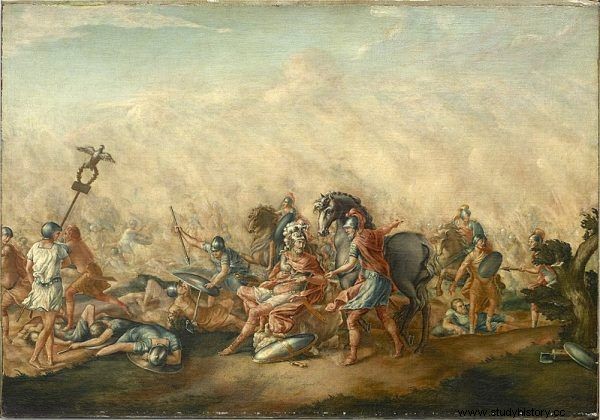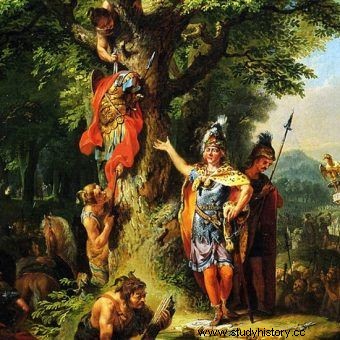Reluctance. Rivalry. Exorbitant ambitions. And sometimes just complete thoughtlessness. The stories of these Roman leaders prove that even the best military will not cope with the wrong man at its head. And even worse when there are two people - now we know that misfortunes really do come in pairs.
Rome has conquered vast territory. Maintaining it and expanding it meant constant wars, both offensive and defensive. The leaders of the empire achieved spectacular success ... and equally spectacular failures. Who deserved a place in the infamous ranking of the worst commanders fighting for the Eternal City?
Lucius Aemilius Paulus and Gaius Terentius Varro
For several hundred years, Rome competed with Carthage for dominance in the Mediterranean. Subsequent wars finally brought victory to the metropolis from the Apennine Peninsula, although it seems that he had a stroke of luck in this. Especially if one carefully analyzes the series of defeats suffered by the legions during the Second Punic War:Rodan and Trebia in 218 BC, Lake Trasimeno a year later ...
But it was the Battle of Cannae in 216 BC that was remembered as an absolute defeat. As Max Cary and Howard Hayes Scullard argue in "The History of Rome":
In 216, however, the Romans made the enemy's task easier . Instead of, in line with Roman practice, calmly analyze the enemy's way of war and adapt their own methods to it, they decided - regardless of the greater military skills of the Carthaginians - to make a massive infantry attack and lead to a direct clash between the two armies.
80,000 legionnaires, led by consuls Lucius Emilius Paulus and Gaius Terentius Varro, stood against Hannibal's 50,000 army. However, the Carthaginian chief won thanks to his brilliant tactics. He placed weaker troops in the center and directed his best troops to the wings. Thus, he dragged the Romans, who aimed the main blow to the center, into a death trap. The empire lost 70,000 soldiers and 6,000 were captured. The losses of the Carthaginians amounted to only 7,000 people.

The ill-considered tactics and mutual animosities of the commanders led to the defeat. Paulus also died on the battlefield.
The tactics chosen by the rash consuls turned out to be tragic. It certainly did not help the fact that, rather than defeating the enemy, they were focusing on mutual competition for the favor of the senate and the recognition of their fellow citizens. As a result, they suffered a shameful defeat. And they paid for it. Paulus died on the battlefield, and Varro escaped alive, but his position in the Senate could not have been worse. At least for some time, because later he held political positions again, and the senators even thanked him "for his faith in the Republic" ...
Gnaeus Maliusz Maksymus and Quintus Servilius Cepion
More than a century after the Battle of Cannae, in 105 BC, the Romans recorded another gigantic defeat, which was the result of the evident mistakes of two commanders. Consul Gnaeus Maliusz Maximus and proconsul Quintus Servilius Cepion set out against the Germanic tribes of the Cimbri and Teutons ... and competed in secret for the "honor" of defeating the barbarians. Paweł Rochala in the text "Empire on the brink of destruction" explains the relations between them in this way:
In assigning identical tasks to both chiefs, the Senate made one fundamental mistake - it failed to take into account that both gentlemen disliked each other very much. Nobody thought that their personal animosities would prove more important to them than the security of their homeland . The development of further events indicated that by electing these people as consuls, the Roman people not only neglected the matter of their mutual relations, but also did not take into account their intellectual qualities and military experience [...].
Problems did not take long to come. First, Cepion did not want to recognize the sovereignty of Maximus, who replaced him as consul in Transalpine Gaul. Both commanders led separate armies - strong but poorly managed. Attempts to ease the dispute have been of no avail. Paweł Rochala argues:
It became clear to everyone that although there were two very strong Roman armies in two fortified camps at Arausio, both were commanded by extremely dull and incompetent , and in addition they were charmed by the will to lead the leaders at any cost that cannot be trusted.

Varus fell into a trap that killed 20,000 legionnaires.
The clash at Arausio, which took place on October 6, 105, before Christyus, resulted in the complete annihilation of an army of nearly 80,000 - or, in fact, two armies. Soon after the battle, news reached Rome, awaiting the results of the expedition, that the legionaries had been smashed and the prisoners were hanged on nearby trees.
Marcus Licinius Crassus
Marek Liciniusz Crassus was a real statesman, a bright entrepreneur and a talented politician. For many years, however, he deluded himself that he would also be a brilliant leader. His hope was partially fulfilled in 71 BC when he managed to suppress the Spartacus uprising hostile to Rome, although it must be remembered that he achieved this mainly by avoiding direct confrontation .
The victory over the slaves did not fulfill his ambitions. As governor of Syria in 53 BC, Crassus set off against the Party, a country hostile to Rome for years. It just didn't take into account that it had a poor military base. Worse, by not following the advice of his staff, he quickly redirected his troops deep into Mesopotamia. His legions were surrounded by the enemy's great cavalry at the Carrhae. They were forced to retreat - without a commander, because he reportedly died while trying to negotiate with Surena, the party leader.

Crassus was killed by the Parthians. His head and arm were used as props in the theater.
20,000 legionnaires were killed during the battle. 10,000 were captured, and only 10,000 were saved. Crassus' body was desecrated: his head and right arm were cut off and used as props in the theater . And the situation in the East was never the same again. Only now did the Romans realize that the power of the Parthians really had to be reckoned with.
Publius Quintilius Varus
Sometimes the victorious march of even the largest army can be stopped. It is enough for someone like Publius Quintilius Varus to be at its head. This politician appointed governor of Germania did not understand the essence of his office at all. Among other things, through his hasty fiscal decisions, he led in 9 AD to the outbreak of an anti-Roman uprising led by Arminius.
Convinced of his abilities, Varus was then lured into the Teutoburg Forest, where his legionaries were attacked by enemy forces. When he saw that he had fallen into a trap, committed suicide, leaving his people to the prey of cruel hostile tribes . Nearly 20,000 legionnaires were slaughtered.
The battle was called by many chroniclers "Clades Variana", or "slaughter of Varus" . "It is hard to resist the impression that the actions of Varus show thoughtlessness in whatever area he did," comments Rochala. One thing is for sure. The Emperor Augustus clung to the Rhine border in the following years and did not think about further expansion of the country's borders.
Flavius Julius Valens
The Roman army suffered another spectacular defeat at Adrianople, this time as a result of the emperor's exuberant personal ambitions. Valens, ruling in the eastern part of the empire, set off in 378 on an expedition against the Goths. He was in a hurry - he wanted to win even before the arrival of his co-ruler Gratian . He did not exercise proper caution - he trusted the scouts' information that the enemy forces only numbered about 10,000 men. So he threw his 60,000 troops, tired and thirsty after a day's march, to attack.

20,000 Roman legionnaires died in the Teutoburg Forest. Arminius triumphed.
He quickly regretted his rash step. The effective counterattack of the Gothic cavalry meant that the Romans were deprived of the support of their horse troops. Soon the Goths tightened the battlefield and crushed the Roman infantry as well. Valens was killed instantly, and almost his entire army was destroyed. This is how the historians Max Cary and Howard Hayes Scullard sum up Walens' failure:
The Eastern Roman Empire experienced neither major civil wars nor heavy invasions. The most critical period came after AD 378, when co-emperor Valens fell on the battlefield with the Goths.
Although there have been bad commanders in the history of Rome, it is worth emphasizing that the empire has not suffered many humiliating losers in its long history. This may prove the class and quality of education in the war trade. The leaders of the Eternal City were also able to admit defeat. According to Andrzej Grackowski, the commander-in-chief, at the head of the army, at the time of defeat, instead of a scarlet cloak, he wore gray. "After the failure at the front with the Parthians, Crassus and Antony demanded a black robe instead of the commander's purple" - he reports.
Inspiration:
The story was inspired by the story of Geraint Jones' book Blood Forest (Rebis 2019) - a story about Roman legionnaires who fought a life and death battle with rebel Germans.
